I’ve gathered every crow and raven I’ve ever painted…
…and made them into a series of art prints and canvasses.
For a closer look, click the dark birds below!
For many days, during a stormy autumn week…
…I locked myself in my studio.
This is the progress of a large new acrylic-on-canvas painting titled ‘Thy Winter is Forever.’
Please enjoy…
It began with the background. Two coats of heavy acrylic paint. I used a wet brush to blend the colors together. Blue, green, purple, white, cream, grey, black…and more. This took about two days, and another half-day to dry.
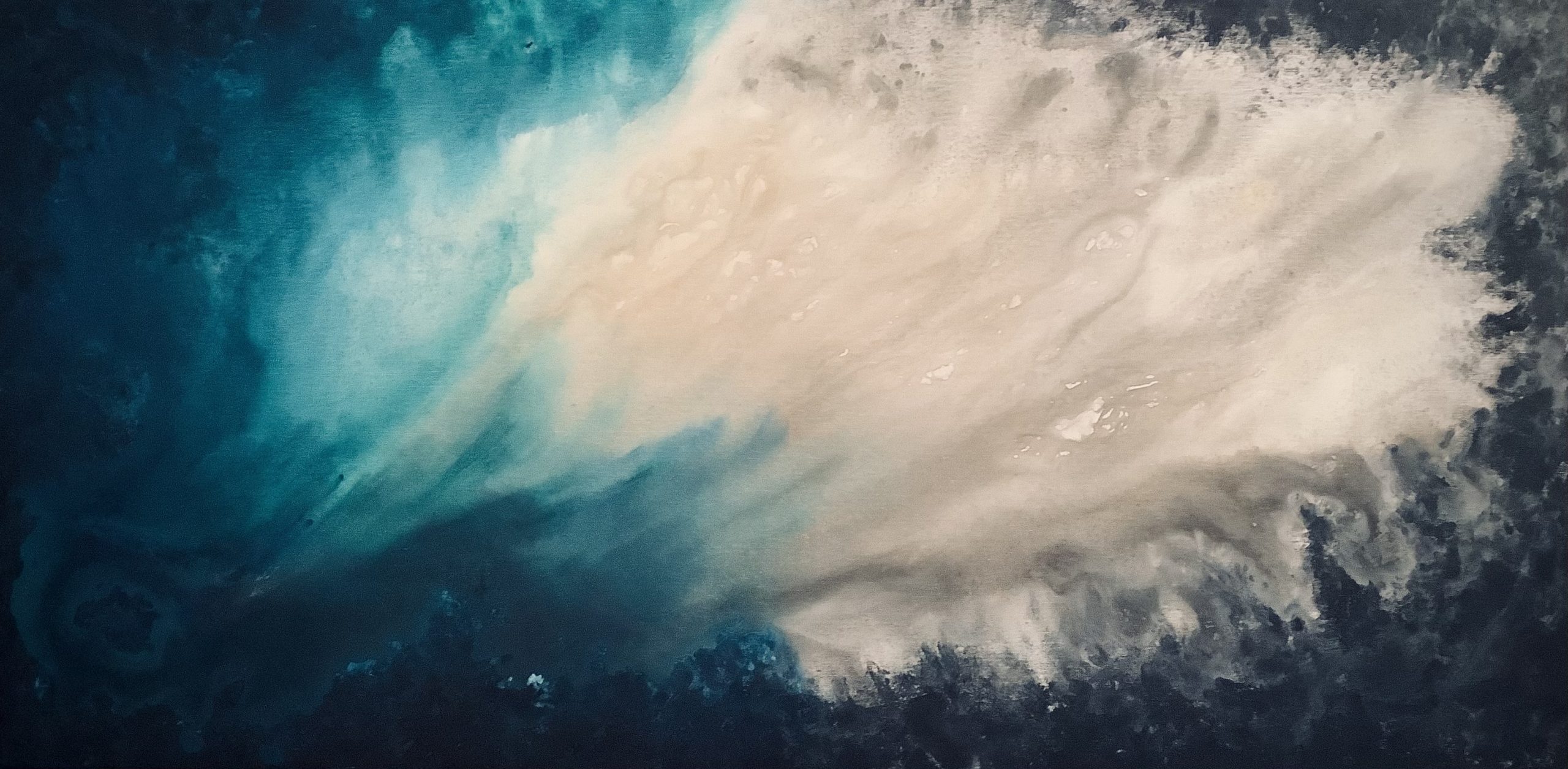
Next, I began sketching, sketching, sketching. I used a black (soft-nose) colored pencil. Easy to erase. Easy to paint over. For the hands, I photographed my own fingers in various poses. In truth, this was one of my favorite parts of the process…
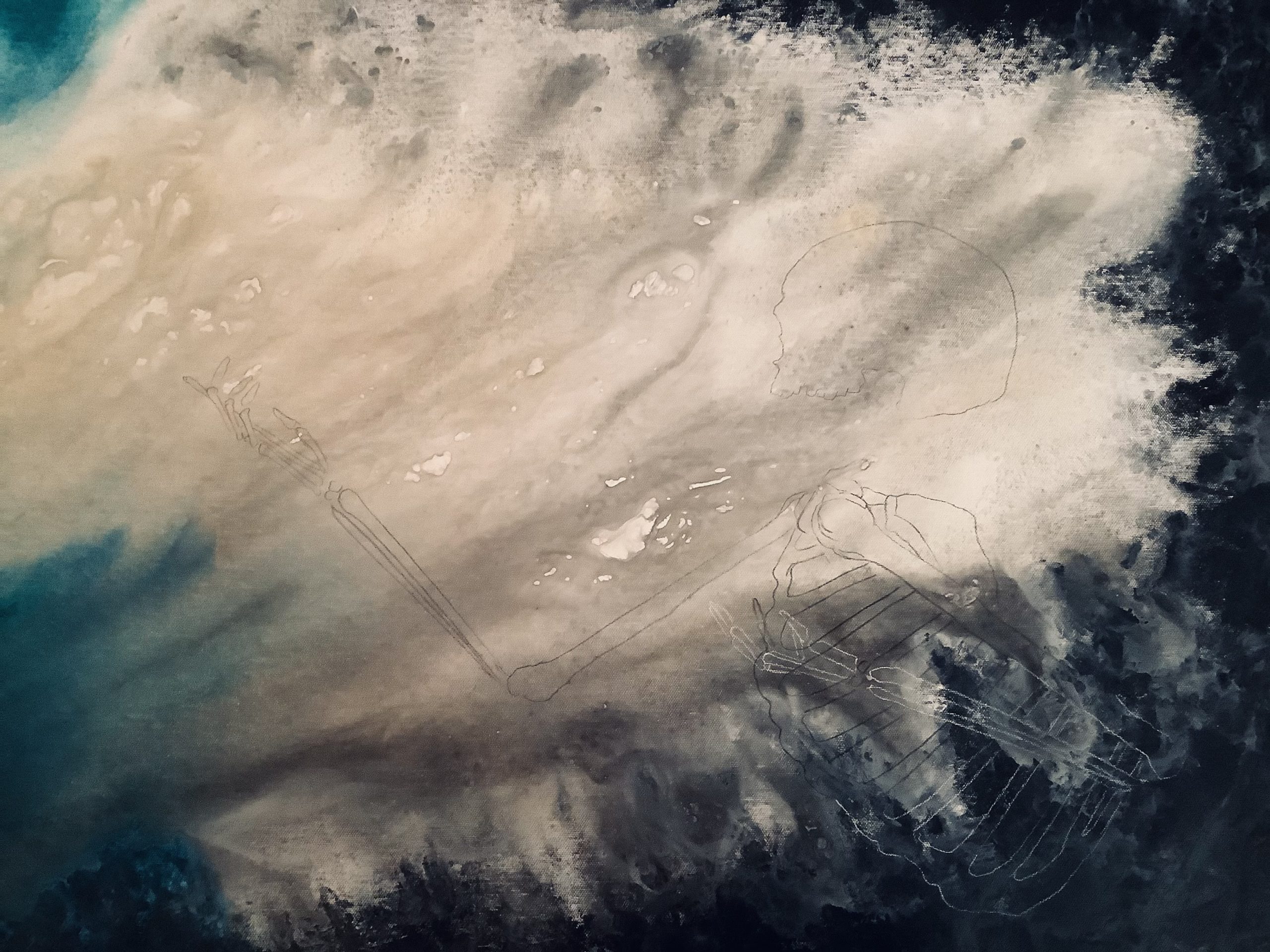
It looks like matte black paint, right? Only, it’s not. The subtle greys I added to the skeleton undertones show up better when viewed in-person. For my painter friends out there, I recommend rarely using straight black. Add a second & third color, mix well, and achieve a nice texture which black alone cannot match.
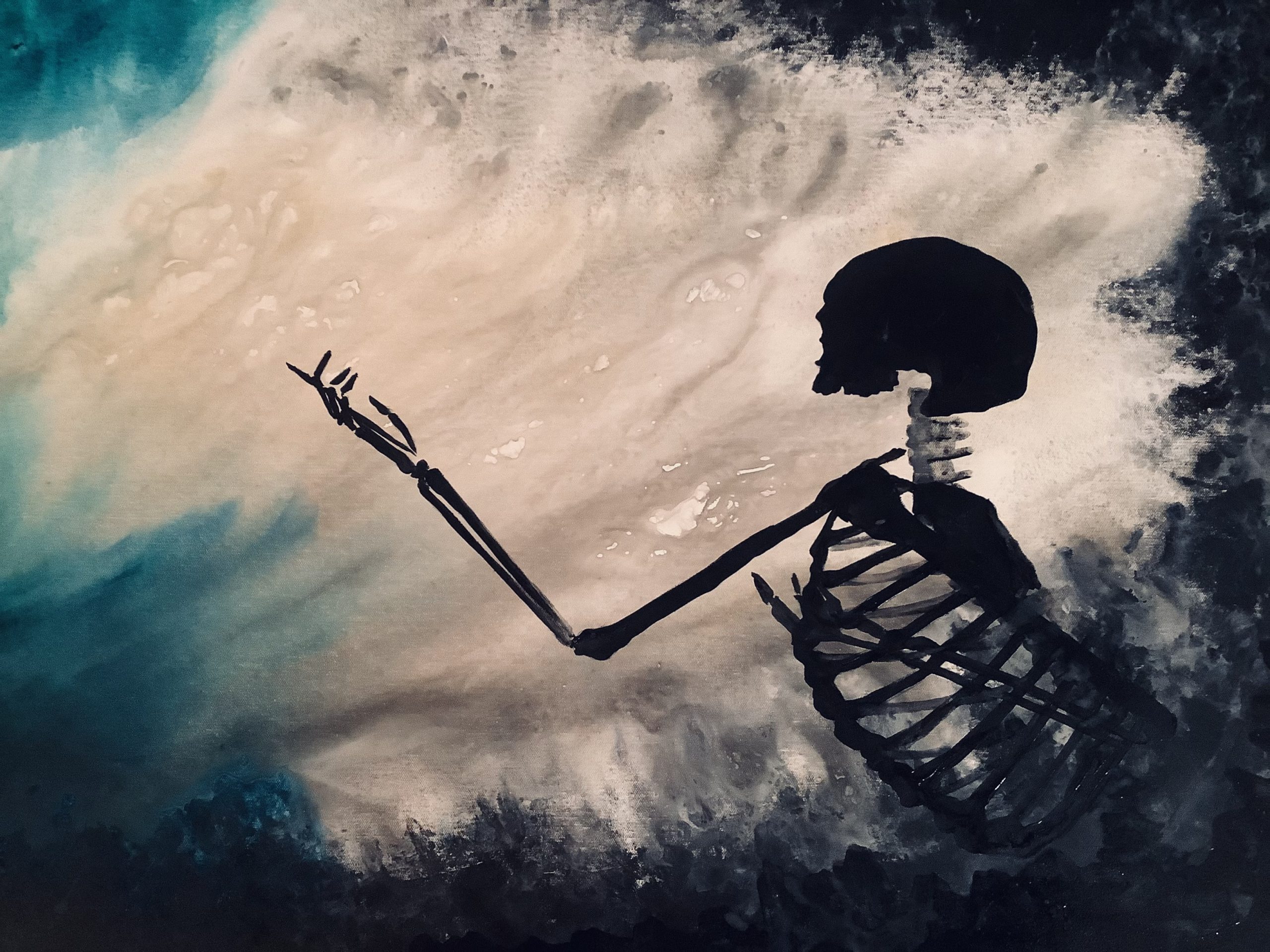
I sketched in the birds, and then painted them using the same black/grey mix as the skeleton. The wings were hard, but fun! For this entire painting, I worked right to left. Which…normally…as a predominantly right-handed artist, I’d recommend the opposite. Whatever…
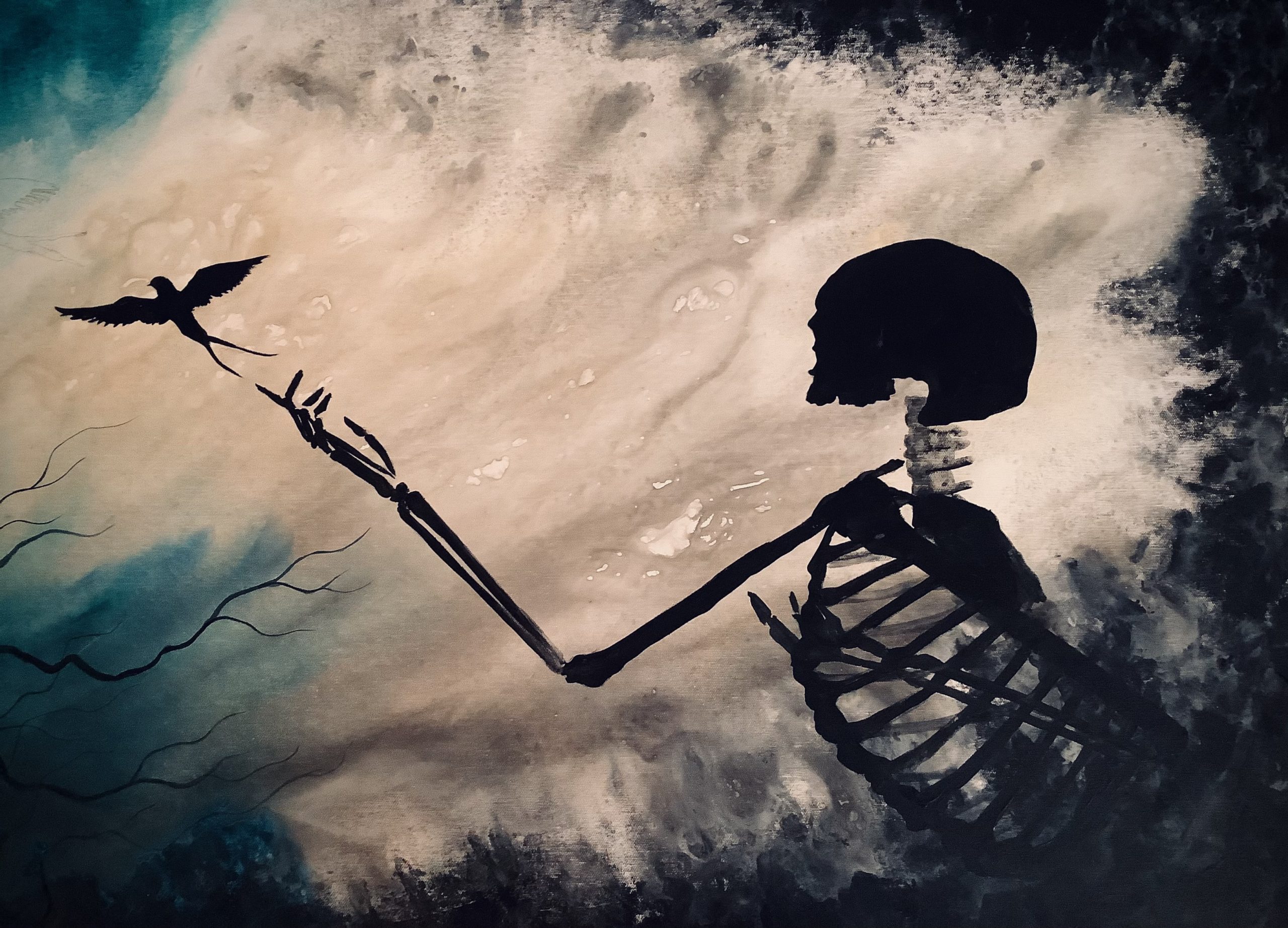
More sketching, sketching, sketching. I paused to add the foremost tree to make sure my birds ended up in the right spot. And who doesn’t love a nice dead tree? Am I right?
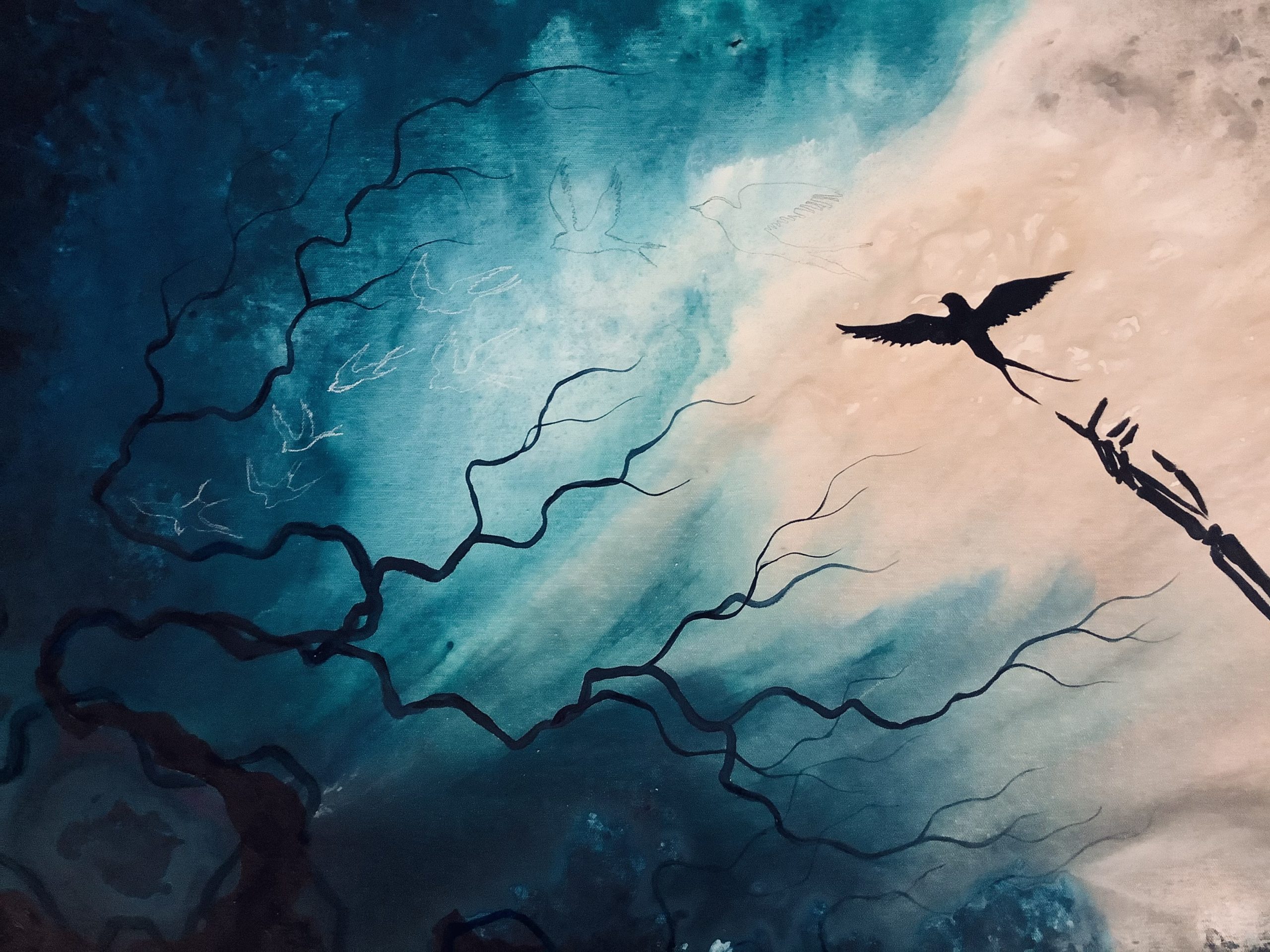
Next, I went in with a few soft details on the skeleton and several background elements, including bones and distant tree limbs. Those poor birds. They’re still waiting on me…
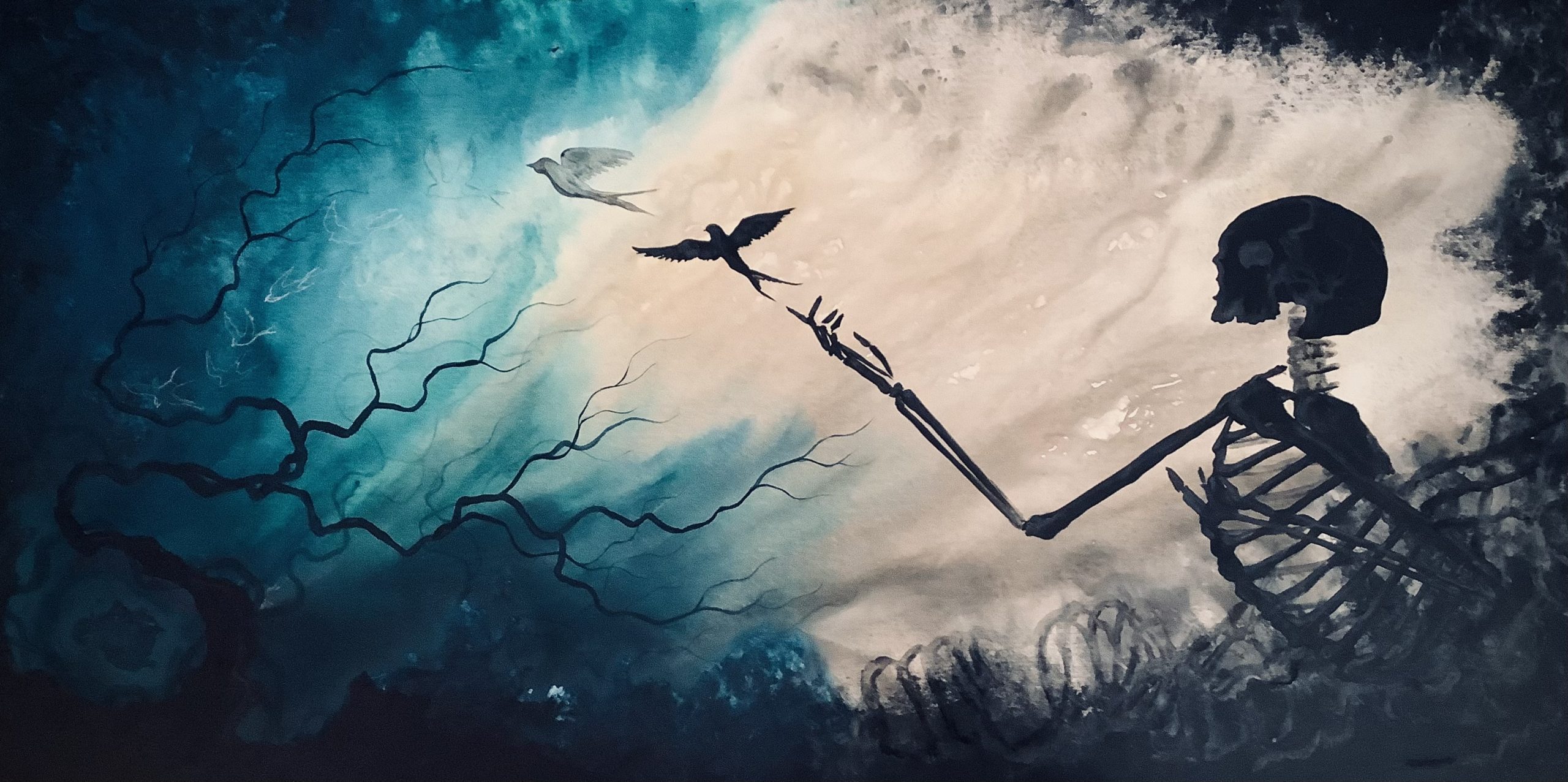
Ah ha! Finally, the birds got their due. And look! Snowflakes! The birds swooping into snow was the original idea for this painting, a scene imagined by my lovely bride. Thanks, Heather!
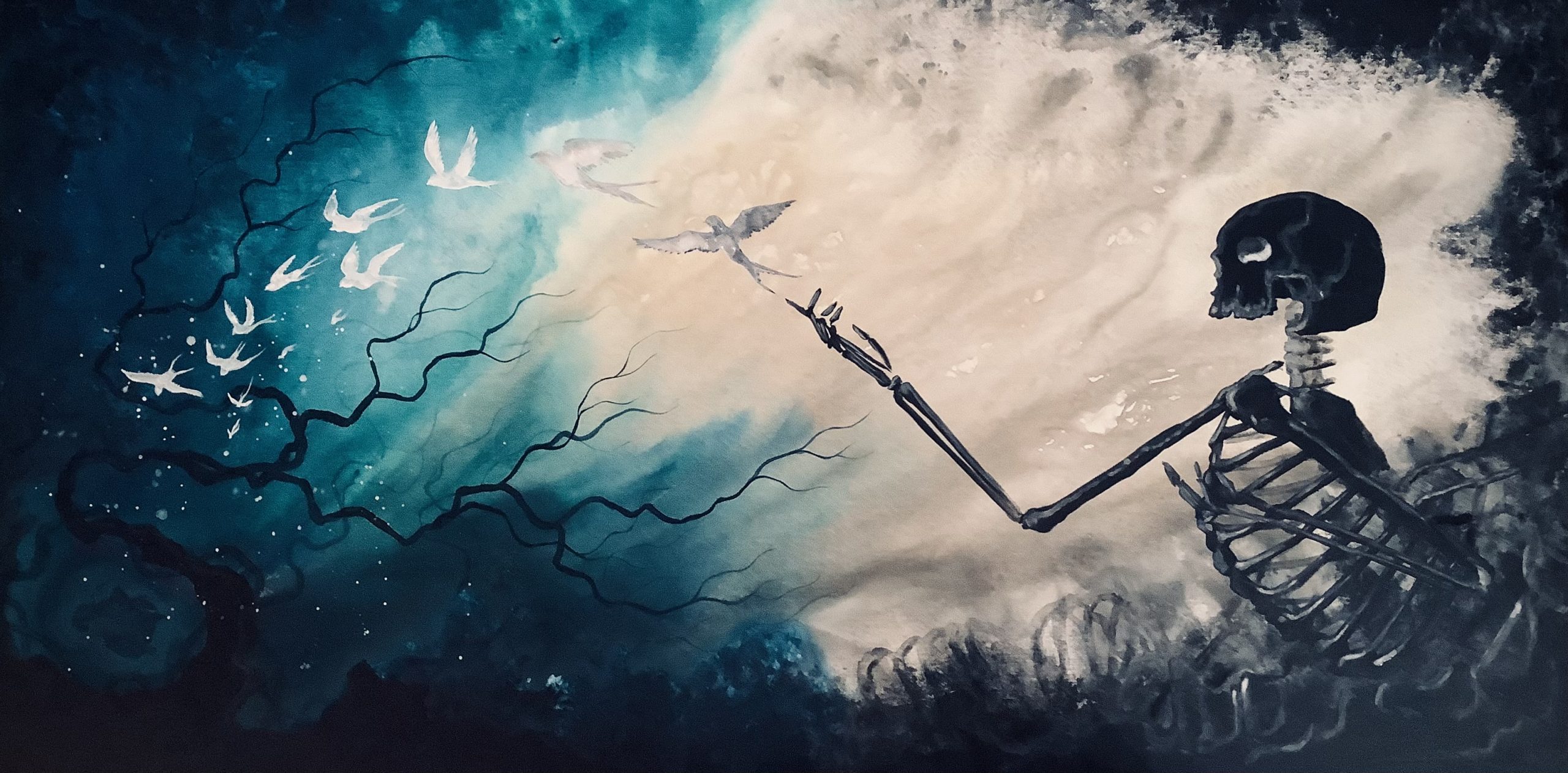
The snow begins to settle on the branches. And the details on the skeleton begin to emerge. This is no evil creature with which we’re dealing. He’s giving winter its essence, its lifeforce. An important task, yes?
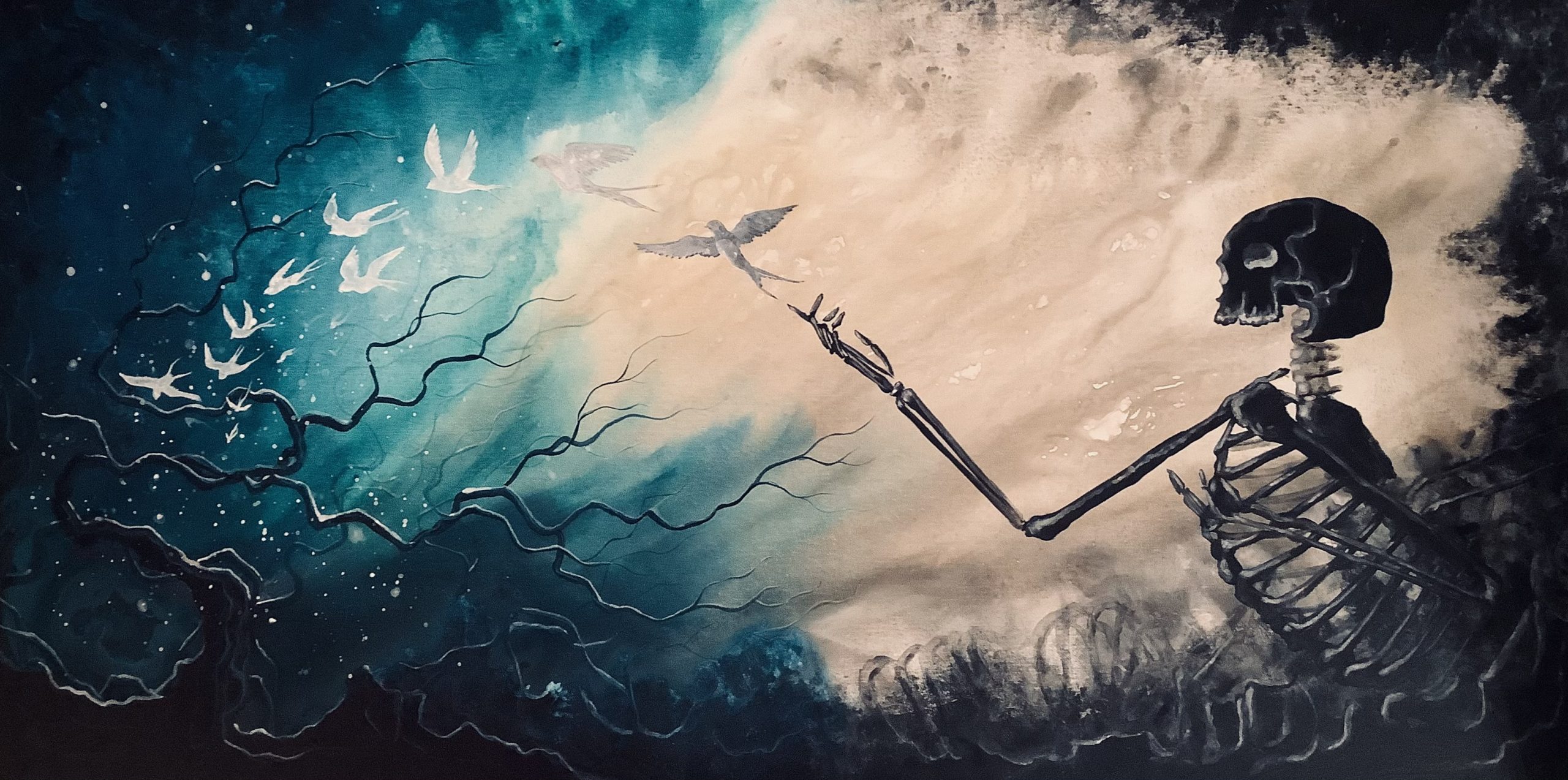
A close-up of the left side. Still a ways to go…
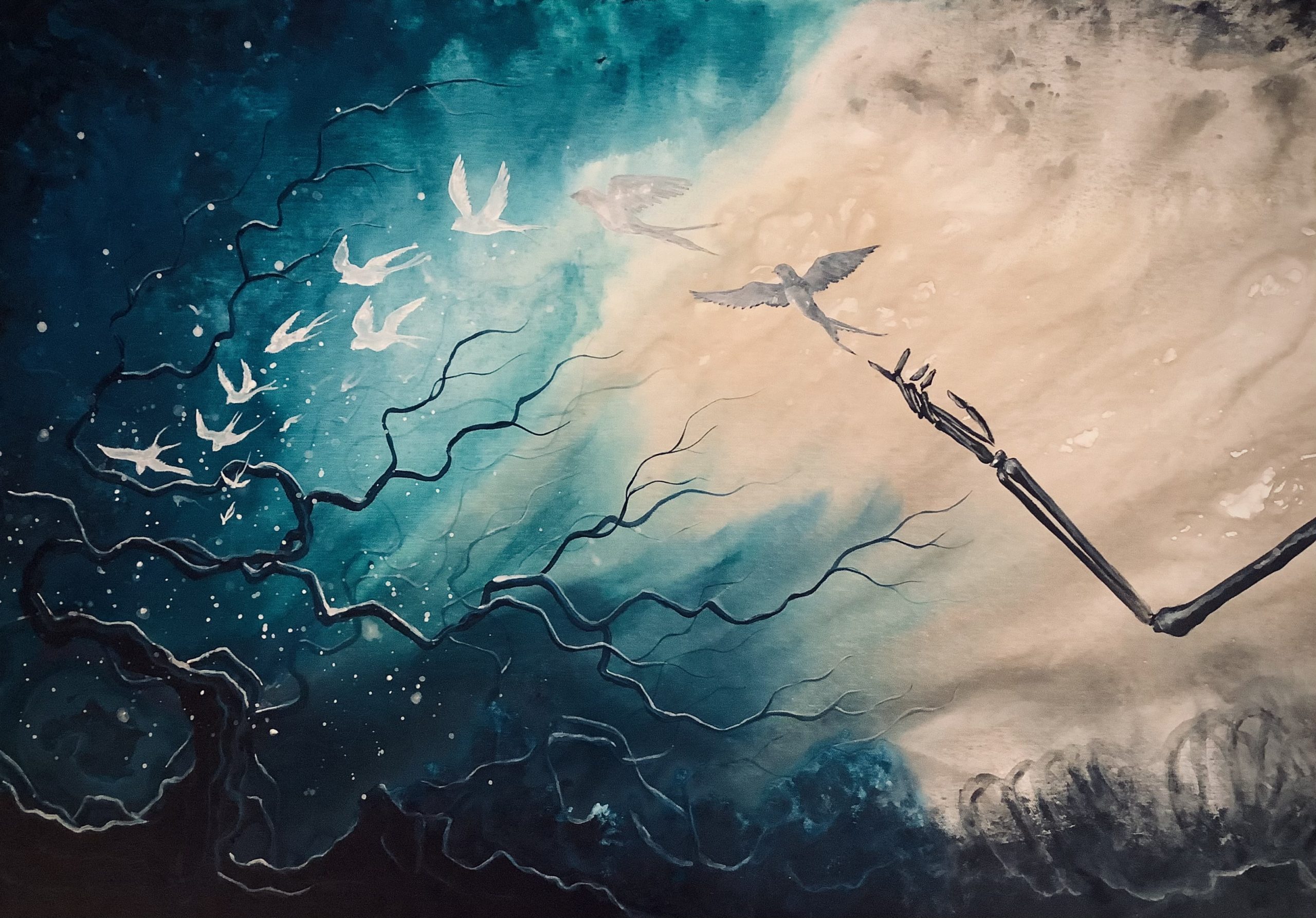
And a close-up of the right side. Such a gentle giant, Skelly is…
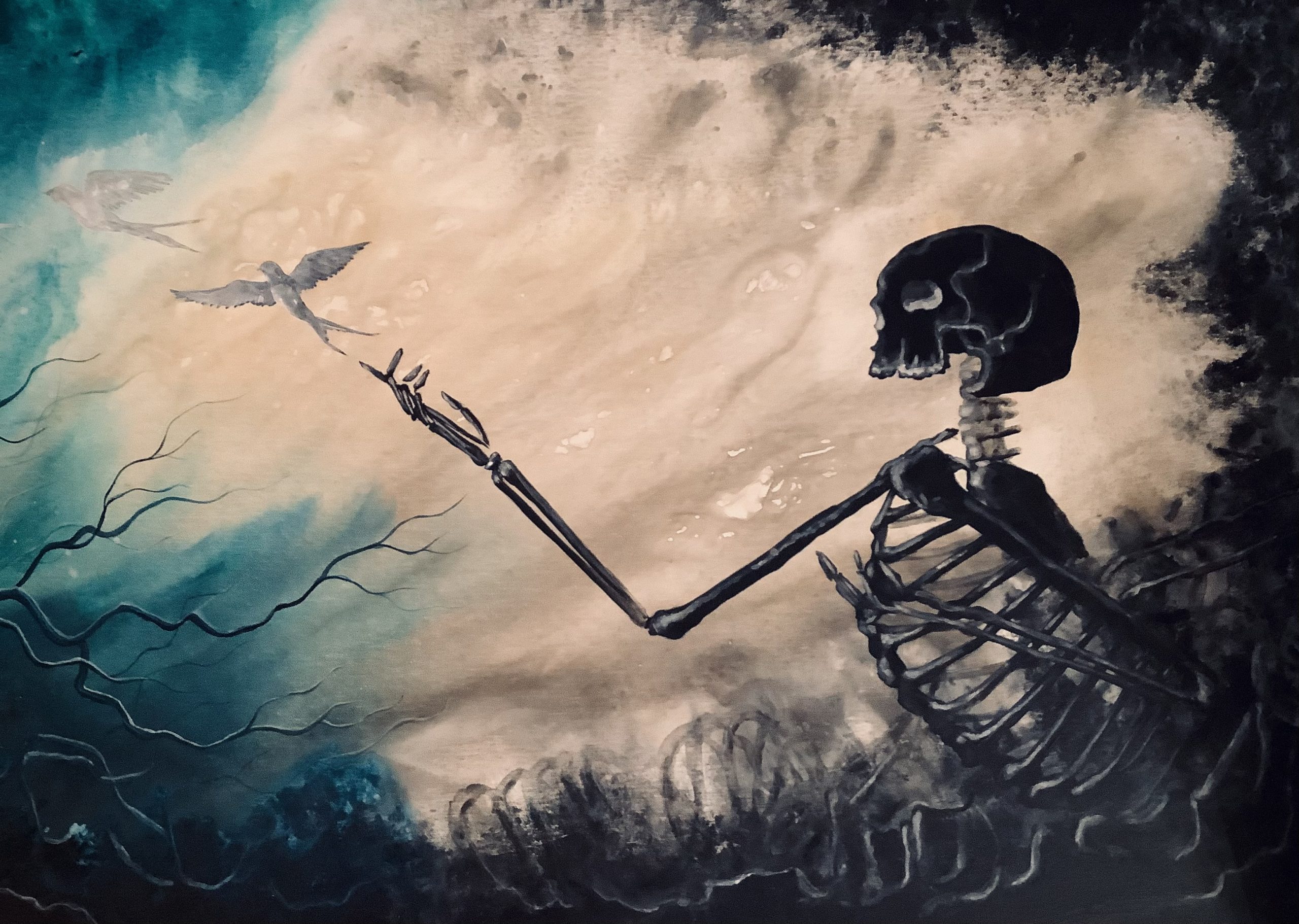
And finally, we arrive at the end. Tiny touches of white for the snow and the crisp winter light falling on Skelly’s bones. And most importantly, the painstaking details of the snow settled on each branch, big & small.
I hope you like it!
(To see even more pics, click the final image below.)
You voted.
I listened.
Here’s a fresh new video detailing the inspiration and creation of my painting ‘Mirror of Ourselves.’
To watch, just click the painting picture below.
Enjoy!
Hey everyone. How’s it going?
So…
At last, I’ve decided to offer something resembling commissioned artwork.
But it might not be what you think…
I’m going to offer commissioned backgrounds. Meaning, I’ll create a background (no subject matter or details) using my style. You’ll select the size of the canvas, the colors you want me to use, and the general position of the colors.
And I’ll paint it and ship it to you.
How does it work?
First, you’ll click this here link to get started.
Then…
1. You’ll select a canvas size
2. You’ll choose a color combination for me to use (choose any colors in the rainbow, but typically 2-4 colors are ideal.)
3. You’ll choose a color orientation (or select a similar painting from my huge catalog here to let me know the general idea of how you’d like me to position the colors on your canvas.)
4. I’ll paint a background using my acrylic blending technique, and when finished, I’ll send you photos of the finished background.
5. You decide whether you like the background (Meaning I’ll ship it) or you don’t like it (Meaning I’ll refund your money 100% and use the painting for my own work.)
It’s that easy.
The sizes available are:
20″ x 16″ x 1″
36″ x 12″ x 2″ (Deep-edge canvas)
36″ x 24″ x 2″ (Deep-edge canvas)
48″ x 24″ x 2″ (Deep-edge canvas)
You’ll select the canvas size upon purchase. The colors and orientation, you’ll add to the order notes.
Have questions? Track me down at my many social media outlets here.
Want to get started?
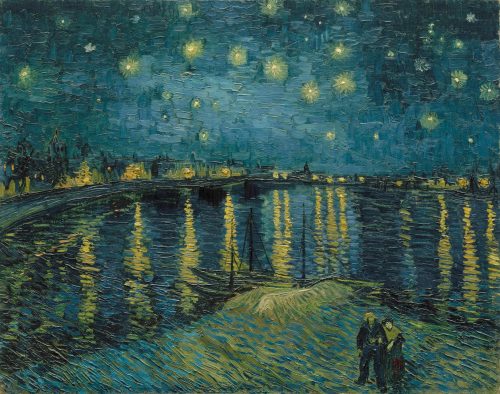
Van Gogh – Stary Night Over The Rhone
This past weekend my wife and I headed out to Atlanta to see the Van Hogh Immersive Experience. Prior to going, I could say that I might have known a couple of his paintings (Stary Night obviously being the big one) and maybe knew two things about him (he died young and cut off his ear for some reason). So you could say this was definitely something we were both walking into a bit blind.
The first portion of the exhibit showed many of his paintings along with information about what inspiration he might have drawn from when he was painting. And while the paintings themselves varied from the more mundane subjects (bedrooms and flowers and the countryside), it was still an amazing accomplishment (a true feat of brilliance by one man). Here was someone who did the majority of his oil paintings and artwork in the final two years of his life. To have a creative output of that level is beyond my understanding, but I could definitely appreciate everything I saw and read about a man who seemed to be so troubled by his own brain that perhaps through his painting he was exorcising the demons within himself?
The main portion is in a very large room where his works are projected on all four walls and the floor. The move to music, telling a story of a man’s passion for capturing the beauty he saw within the world. The images move and flow, they warp and change from darkness to light, from self-portraits to a wheatfield where a murder of crows fly into the night. The music they chose to accompany it is remorseful at times before morphing to match the images we can see.
This is the Immersive Experience. To be able to live within his works, even if only for a little bit of time. To be able to peer inside his head in order to gain a small understanding of what he was trying to say to the rest of the world. Sitting there on the floor with my back against the wall, the rest of the world was only what Van Gogh chose to paint. Reality was a series of short and long brush strokes. Life was a collage of images drawn by someone who had no choice but to bear his soul on the canvas.
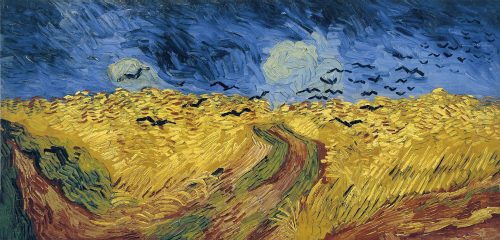
Van Gogh – Wheatfield with Crows
Finally, we had a VR experience where we could see the world around him for ourselves. They had a digital recreation with frames suspended in the air where the painting would take shape. The idea that perhaps, for a second, we might be able to see the beauty he saw in the world and understand why he was moved to paint it.
Yet, as we left the rooms and ventured back to our own reality, the thing that resonated with me the most wasn’t the paintings. Instead it was the various quotes they had from his numerous letters which struck home with me. He wrote so many letters where he bared his soul in a different way than he could do in his art. Those words hit me in a way I wouldn’t have expected. There was clarity to each thought.
Sometimes because it was a beautiful thought:
“There is nothing more truly artistic than to love people.”
“There is peace even in the storm.”
To tragic:
“I put my heart and soul into my work, and I have lost my mind in the process.”
“Art is to console those who are broken by life.”
However, two stood out and really hit home. The first because I’ve recently begun to resurrect a project about Dreams so it felt as if Van Gogh was talking about it directly:
“I dream my painting and I paint my dream.”
And the second because it is something that I need to remember whenever doubt enters into my mind, for it is a singular truth like no other:
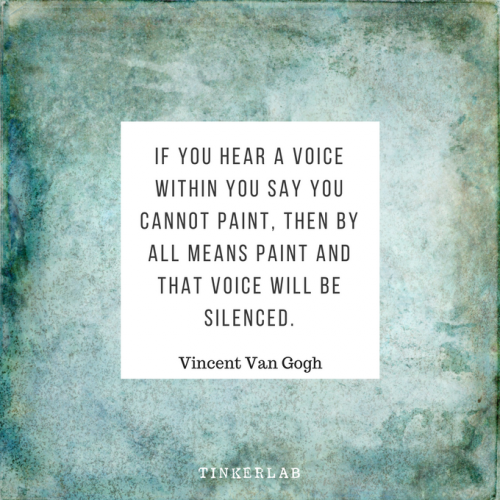
Choose to push through the doubts, the adversity, the days when you don’t want to do anything, the days when you can’t do anything, the days where the blankness of the page is so intimidating that you nearly cry…
“… then by all means paint and that voice will be silenced.”
Silence the doubts.
***
To find out more about the Van Gogh Immersive Experience by going to their website.
***
John McGuire is the writer of the sci-fi novel: The Echo Effect.
He is also the creator/author of the steampunk comic The Gilded Age. If you would like to purchase a copy, go here!
Click here to join John’s mailing list and receive preview chapters of upcoming novels, behind the scenes looks at new comics, and free short stories.
His other prose appears in The Dark That Follows, Hollow Empire, Tales from Vigilante City, Beyond the Gate, and Machina Obscurum – A Collection of Small Shadows.
He can also be found at www.johnrmcguire.com
So…
You say you’re in the market for some art prints.
First of all, awesome. After all, art prints have great upsides. They’re an inexpensive alternative to buying original art. They’re typically smaller than big canvas paintings. They can be put into stylish frames. They’re easier to handle, and even replace, than larger, hard-to-ship art.
Sounds great, right?
But there’s just one question.
How do you know what type of art print is right for you?
Now, when we talk about the ‘type’ of art print, we’re not looking at the art style. That’s a entirely different conversation. Maybe you like kittens, or watercolors, or abstract art, or…if you’re looking at my work, crazy dark surrealism. It’s all good. But what we’re talking about today is the material of which your future art print will be made of. Be it photograph paper, inkjet lustre prints, velvet giclees, canvas prints, or mounted canvas, there are more styles of print than most people realize.
Many, many more.
Which is a good thing. It’s always nice to have options, right?
Let’s get straight to it.
*
Photographic style prints are your entry-level art print. If you buy from most artists, this is the basic style they will offer. Photo-style prints are inexpensive, durable, and provide a quality that most art-lovers find very much acceptable.
What’s the scoop?
This type of print typically uses dyed inks on digital photograph paper. If you’ve ever held an actual photograph in your hand (I say this only because so many photos these days are strictly digital) then you have a general idea for the quality of a photo print. The paper stock used is thicker than standard printer paper. It’s durable stuff, and the colors of most paintings (especially line art or art with plenty of strong, bold colors) will look good. It’s easy to frame, easy to ship, and not particularly pricey. What’s more, this style of print can be made to be glossy, semi-glossy, matte, or even metallic, depending on the artist’s (or buyer’s) tastes.
In short, it’s versatile stuff. And in today’s ever-growing art market, it’s what you’ll see a ton of.
*
Suppose you want to step up your art print game. You want better color saturation. Better paper. Something longer lasting.
And more than anything, you want an art print that picks up every detail of the original artist’s work.
Giclee prints might be for you.
In today’s world, there are many styles of giclee prints. There’s deep matte, a printing process which carves out any hint of shine, leaving only the deep, dark details. There’s somerset velvet, a smooth, luxurious-feeling print, capturing the subtle color notes in a detailed piece of art. If you see words like Lexjet, Lexjet matte, Somerset velvet, or 100% cotton, then you’re dealing with a high-quality giclee.
In short, giclees are gallery-quality prints printed using pigmented inks (instead of dyed inks) on archival (typically cotton) paper. If the original is unavailable, and a buyer, gallery, or even the original artist wants an excellent reproduction, giclees are most likely what they’ll go for. The paper is much higher quality than photo paper, which allows excellent color saturation and detail. When framed properly, a good giclee will resemble the original painting in almost every way (unless it was a highly-textured original.)
The only drawback? With giclees, buyers should expect to pay two to four times more than the price of a standard photographic print.
As the saying goes, you get what you pay for.
*
Still further up the art print ladder, we find canvas prints.
Similar to giclees, canvas prints typically are excellent, top-notch reproductions of art. Whether created by traditional artists after their originals have sold or by digital artists who desire a physical copy of their work, canvas prints are a superb method of displaying art.
Firstly, they’re flexible. Printed on the thickest, most durable materials, canvas prints are bendy, tough to damage, and easy to trim/manipulate for framing. Even more than giclees, they’re a long-lasting print style, and can be varnished with protective coatings to last many decades (or possibly even centuries…given that the technology used to create them is still relatively new.)
If you’re a collector who wants the best possible reproduction of a piece of art, canvas prints are likely for you.
The good news? While pricier than inkjet or photo prints, canvas prints are typically only 10-25% more expensive than giclees.
The challenge? Canvas prints come loose and in need of (usually high-quality) framing.
*
Mounted canvas prints are quite simple, really.
They’re the same as canvas prints, same material, same color quality, same durability.
But they’re stretched and mounted on a wooden frame, and are 100% ready to hang.
For collectors who don’t want to pick out custom frames, and for art-lovers who like to hang art just as it looked in the original artist’s studio, mounted canvasses are a great option. Like standard canvas prints, they can be varnished. The wooden frames (typically 1/2″ to 2″ thick) offer stability, ease of hanging, and true-to-life colors which often match the original work.
Personally, I’ve hung multiple mounted canvasses of my own work (after the originals are gone) and I can’t really tell the difference between them and the original paintings.
They’re that good.
The good part? Original-looking art which typically costs far less than original paintings.
The only drawback? The cost of stretching and mounting the canvas is significant, meaning these are usually the most expensive print option.
*
*
Of course, there are other print options out there. Custom paper styles. Custom finishes. But in general, 95% of what collectors will see in the market today will fall under these four art prints styles.
I hope, for all you art-lovers and artists out there, this article proved helpful. If you have questions or want to chat about print styles, reach out to me at any of my social media links right here.
And of course, I invite you to take a look at my own selection of art prints. Click the pic below and fall into my surreal world.
*
Until next time…
*
J Edward Neill
*